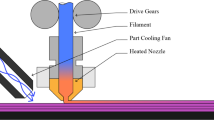Abstract
Fluid dispensing is a method by which fluid materials, such as epoxy, adhesive, and encapsulant, are delivered in a controlled manner in electronics packaging. This paper presents a brief review of past and recent developments in the modeling and control of the time-pressure fluid dispensing process. In particular, the characterization of the fluid flow behavior is addressed by reviewing several promising models from both time-independent and time-dependent perspectives. In the modeling of the time-pressure fluid dispensing process, various approaches for representing the flow rate of fluid dispensed and the profile of fluid formed on target are examined; and the issues involved are identified. In the control of time-pressure dispensing process, a brief review of various control methods is presented along with their limitations. The challenges associated with this control problem are also discussed. This paper is concluded with the recommendations of research in the future.
Similar content being viewed by others
References
Quinones H et al (2000) Flip Chip and Chip Scale Packaging Technologies: A Historical Perspective and Future Challenges. SEMICON China 2000 Technical Symposium
Han S, Wang KK (1997) Analysis of the flow of encapsulant during underfill encapsulation of flip-chips. IEEE Trans Compon Packag Manuf Technol—Part B 20:424–433
Tummala RR, Rymaszewski EJ (1989) Microelectronic packaging handbook. Nostrand_Reinhold, New York
Boulanger R (2001) Chapter 41: Assembly Processes, Printed Circuits Handbook, Editor-in-Chief: C. F. Coombs, Mcgraw-Hall
Dixon D et al (1997) Practical issues concerning dispensing pump technologies. Circuits Assem 36–40, August
Cavallaro WA et al. (1998) Method and Apparatus for Measuring the Size of Drops of a Viscous Material Dispensed from a Dispensing System. United States Patent, no. 5837892
Chen XB, Schoenau G, Zhang WJ (2002) On the flow rate dynamics in time-pressure dispensing processes. ASME J Dyn Syst Meas Contr 124:693–698, doi:10.1115/1.1514058
West AA, Williams DJ, Hinde CJ (1995) Experience of the application of intelligent control paradigms to real manufacturing processes. Proc Instn Mech Engrs 209:293–308, doi:10.1243/PIME_PROC_1995_209_396_02
C. A. Bretmersky et al. (1999) Method of compensating for changes in flow characteristics of a dispensed fluid. United States Patent, no. 5995909
Chen XB et al (2003) Off-line control of time-pressure dispensing processes for electronic packaging. IEEE Trans Electr Packag Manuf 26:286–293
Reighard MA et al. (2001) Viscous material dispensing system and method with feedback control. United States Patent, no. 6173864
Bouras CE et al. (1999) Flip chip underfill system and method. United States Patent, no. 5906682
Skelland AHP (1967) Non-Newtonian flow and heat transfer. Wiley, New York
Holdsworth SD (1993) Rheological models used for the prediction of the flow properties of food products: a literature review. Trans Inst Chem Eng 71(C3):139–179
Razban A (1993) Intelligent control of an automated adhesive dispensing cell. Ph.D Thesis, Imperial College, London, UK
Razban A, Davies BL (1995) Analytical modelling of the automated dispensing of adhesive material. J Adhes Sci Technol 9:1435–1450, doi:10.1163/156856195X00112
Chen XB, Ke H (2006) Effects of fluid properties on dispensing processes for electronics packaging. IEEE Trans Electr Packag Manuf 29(2):75–82, doi:10.1109/TEPM.2006.874964
Martinez-Padilla LP, Hardy J (1989) Quantifying thixotropy of Bechamel sauce under constant shear stress by phenomenological and empirical models. J Texture Stud 20:71–85, doi:10.1111/j.1745-4603.1989.tb00421.x
Cheng DC-H, Evans F (1965) Phenomenological characterization of the rheological behaviour of inelastic reversible thixotropics and antithixotropic fluids. Br J Appl Phys 16:1599–1617, doi:10.1088/0508-3443/16/11/301
De Kee D, Turcotte G (1983) Flow properties of time-dependent foodstuffs. J Rheology 27(6):581–604, doi:10.1122/1.549719
Chan CF et al (1996) Modelling steady and transient rheological properties. J Food Eng 27:63–70, doi:10.1016/0260-8774(94)00077-M
Chen XB (2005) Time-dependent rheological behavior of fluids for electronic packaging. ASME J Electron Packaging 127(4):370–374, doi:10.1115/1.2056568
Kwong CK, Bai H (2005) Fuzzy regression approach to process modeling and optimization of epoxy dispensing. Int J Prod Res 43(12):2359–2375, doi:10.1080/00207540500046137
Nakayama T et al (1980) Pipe transportation of minced fish paste. J Food Sci 45:844–847, doi:10.1111/j.1365-2621.1980.tb07463.x
Chen XB, Schoenau G, Zhang WJ (2000) Modelling of time-pressure fluid dispensing process. IEEE Trans Electr Packag Manuf 23:300–305, doi:10.1109/6104.895075
Zhao YX et al (2004) Integrated modeling of a time-pressure fluid dispensing system electronics manufacturing. Int J Adv Manuf Technol 26:1–9, doi:doi:10.1007/s00170-003-1978-2
Andersen BW (1967) The analysis and design of pneumatic systems. Wiley, New York
Dussan EB (1979) On the spreading of liquids on solid surfaces: static and dynamic contact lines. Annu Rev Fluid Mech 11:371–400, doi:10.1146/annurev.fl.11.010179.002103
Ehrhanrd P, Davis SH (1991) Non-isothermal spreading of liquid drops on horizontal plates. J Fluid Mech 229:365–388, doi:10.1017/S0022112091003063
Haley PJ, Miksis MJ (1991) The effect of the contact line on droplet spreading. J Fluid Mech 223:57–81, doi:10.1017/S0022112091001337
Chen XB, Kai J, Hashemi M (2007) Evaluation of fluid dispensing systems using axiomatic design principles. ASME J Mech Des 129(6):640–648, doi:10.1115/1.2717233
Chen XB, Schoenau G, Zhang WJ (2005) Modeling and control of time-pressure dispensing processes for surface mount technology. IEEE/ASME Trans Mechatron 10(3):326–334
Eggers J (1997) Nonlinear dynamics and breakup of free-surface flows. Rev Mod Phys 69:865–929, doi:10.1103/RevModPhys.69.865
Author information
Authors and Affiliations
Corresponding author
Rights and permissions
About this article
Cite this article
Chen, X.B. Modeling and control of fluid dispensing processes: a state-of-the-art review. Int J Adv Manuf Technol 43, 276–286 (2009). https://doi.org/10.1007/s00170-008-1700-5
Received:
Accepted:
Published:
Issue Date:
DOI: https://doi.org/10.1007/s00170-008-1700-5




